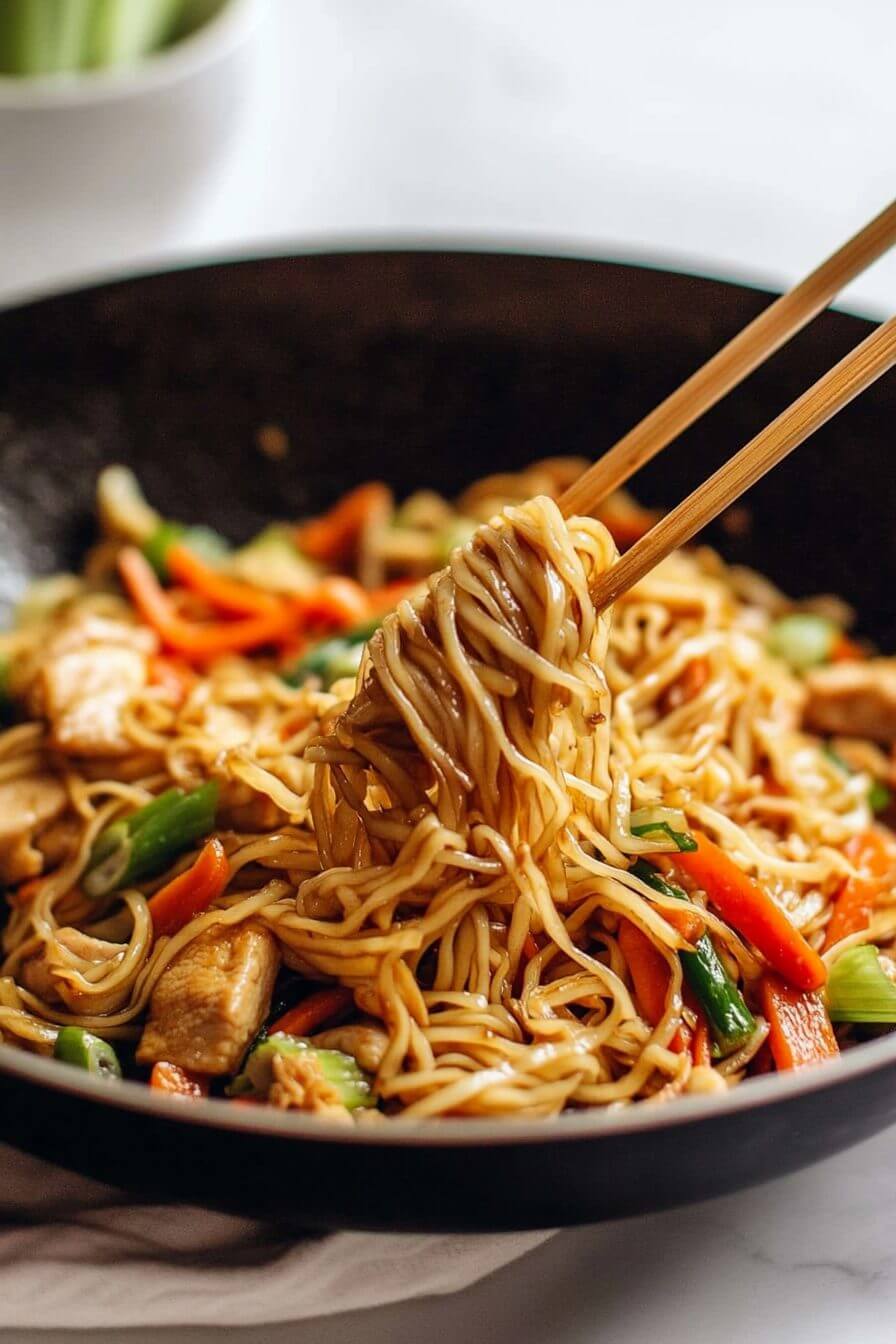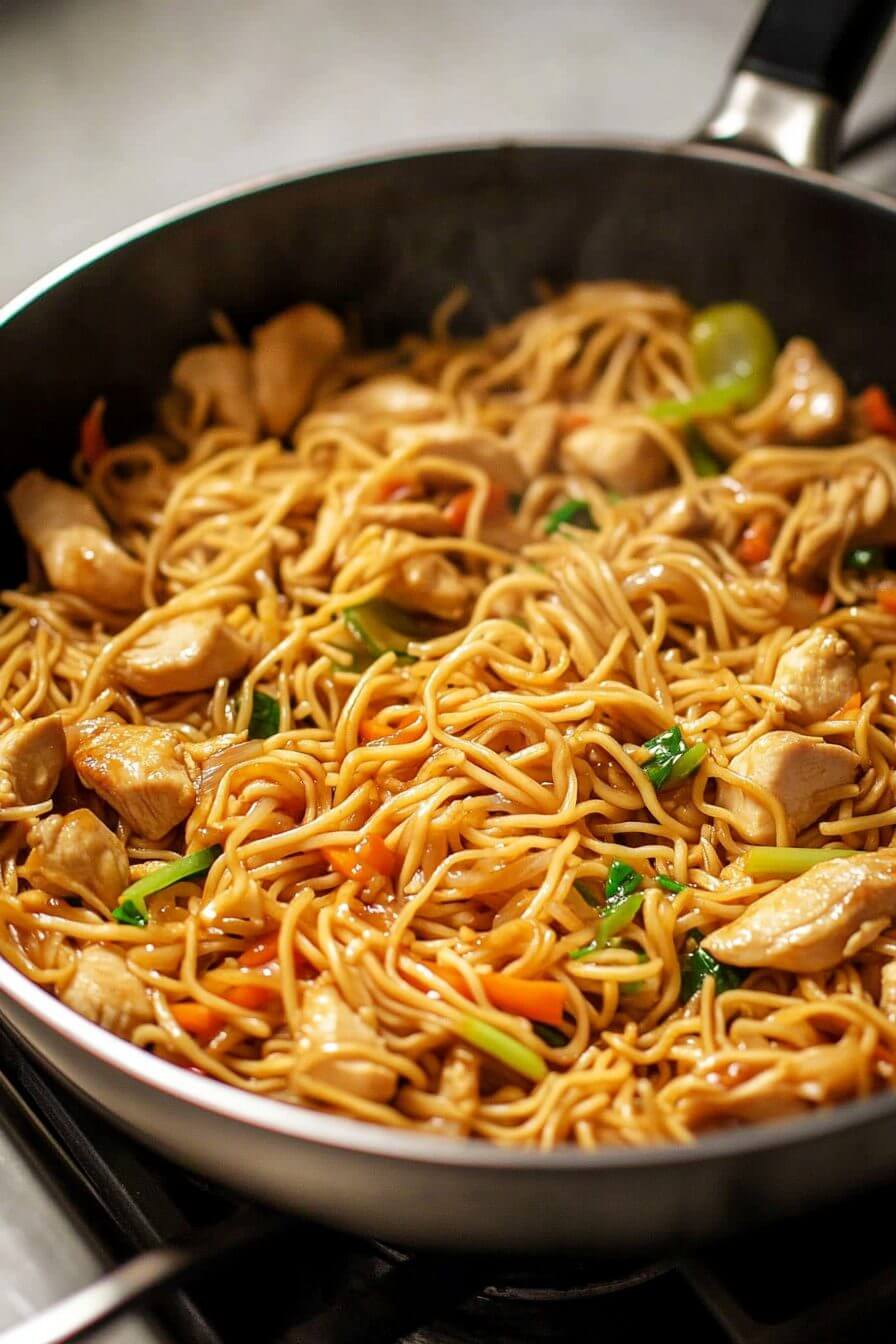You know what? Sometimes, all I honestly want after a long, busy day is a big, cozy skillet of chow mein—loaded with juicy chicken, tender-chewy noodles, and a rainbow of crisp veggies. It’s the sort of dinner that feels just like a warm hug (and, I won’t lie, it’s especially comforting when everybody’s a little grumpy from work or school). Forget complicated tricks or hard-to-find ingredients—this is honest, craveable flavor that smells so good you’ll forget the day’s stress by the time you’re scooping out seconds.
Picture this: you’re breezing through the fridge and spot those hopeless carrots and half a cabbage in your crisper, and suddenly, you’re making something way better than takeout—and way less greasy, too. I’m telling you, that glossy-sauced tangle of veggies and noodles clings to every forkful, and the aroma… well, you’ll definitely have company in the kitchen! (Ask me how I know.)
Why You’ll Love It
- You get a restaurant-worthy sauce—savory but homemade, no weird bottled stuff.
- On your busiest nights, you can get this on the table in under 30 minutes (sometimes even less!).
- It’s super flexible. Sub in shrimp or tofu, or just clean out the veggie drawer. Chow mein doesn’t judge.
- Way lighter than takeout, and you’re in charge of how much salt, sugar, and oil goes in. Win-win!
- Leftovers reheat like a dream (actually, they might be even tastier the next day—no kidding).
Ingredient Notes & Swaps
Let’s chat about the stars of the show, and how to improvise if you’re missing something. Because nobody needs a grocery store run at 5 p.m. (Ask me how I know…)
- Chicken: I usually grab whatever’s at hand—boneless thighs are juicier, breasts cook up tender if you slice thin across the grain. You can also use rotisserie chicken in a pinch! (Skip the stir-fry step and just toss it in at the end.)
- Noodles: Real chow mein noodles are my favorite, but you can totally use lo mein, yakisoba, or even spaghetti when desperate—just give long spaghetti a rough chop before tossing it in, so it’s easier to eat.
- Veggies: Cabbage and carrots bring sweet crunch, but you can load this dish up with anything: bell peppers, snap peas, broccoli florets, mushrooms, or even a handful of spinach at the end. Go wild!
- Sauce: Oyster sauce is magic here, but vegetarian oyster sauce works for a meatless version. Tamari makes it gluten-free, and you can swap chicken broth for veggie broth if needed. Add a dash of fish sauce if you like extra umami—optional but so good.
- Sugar & Cornstarch: Don’t skip these! Sugar balances the salty-savory flavors, and cornstarch makes the sauce cling to every noodle (that glossy finish is everything).
- Oil: Any neutral oil works. I like grapeseed or canola mostly, but if you’re all out, good old vegetable oil is fine. Just avoid olive oil because its flavor is a little strong here.
Quick tip: If you’re sensitive to sodium, use low-sodium soy sauce and rinse your noodles well before adding them in.
Timing and Servings
If you’re the kind of person who needs to know exactly how much time you’re signing up for (me too), here you go:
- Prep time: 10 minutes
- Cook time: 15 minutes
- Total time: roughly 25 minutes (give or take how much you chit-chat or get distracted by your phone)
This recipe generously serves four adults, or a combination of grownups and a couple of kids who “just want noodles.” If you’re cooking for two, just halve the noodles and sauce—and toss the leftovers in a lunchbox for tomorrow’s midday pick-me-up. (Not even a hint of microwave sadness, promise!)
Ingredients
- 1 lb boneless, skinless chicken breast or thighs, thinly sliced
- 3 tbsp neutral oil (like grapeseed or canola)
- 12 oz chow mein noodles (or substitute lo mein or spaghetti)
- 2 cups shredded cabbage (green or Napa—no need to be fancy)
- 1 large carrot, cut in skinny matchsticks
- ½ bunch green onions, thinly sliced
- 2 cloves garlic, minced (or more if you’re a garlic lover—I usually am!)
- 6 tbsp oyster sauce
- 3 tbsp low-sodium soy sauce (use tamari for gluten-free)
- 3 tbsp light (untoasted) sesame oil
- ½ cup chicken broth or water
- 1 tbsp cornstarch
- 1 tbsp granulated sugar
Everything else is negotiable, honestly. Got mushrooms? Toss ‘em in. Snap peas? Why not?
Save This Recipe
Directions
- Mix up that sauce first (don’t skip this!): In a little bowl, whisk together oyster sauce, soy sauce, sesame oil, chicken broth, cornstarch, and sugar until smooth and shiny. Go ahead and sneak a little taste—if you want more sweetness or salt, adjust here. Set aside so it’s ready when things get sizzling.
- Boil your noodles: Cook noodles according to package instructions—shoot for al dente, not mushy. Drain and rinse under cold water right away to keep them perfectly springy, then toss with a swirl of oil if you want to keep them from sticking.
- Stir-fry the chicken: Heat oil in a big skillet or wok on high heat. Add chicken and half your minced garlic (throw in a little ginger if you’re feeling adventurous). Let the chicken get lightly golden—if you avoid moving it constantly, you’ll get caramelized bits that taste amazing. Set chicken aside on a plate.
- Veggie time: With the pan still hot, add cabbage and carrots. Stir-fry 2–3 minutes until just crisp-tender. If you like extra garlic, add the rest now. Feel free to toss in any extra veggies here—don’t worry about being too precise.
- Marry it all together: Return chicken to the pan, add the noodles, and pour over your sauce. Toss with tongs, turning and mixing until every last strand is glossy and the sauce is bubbling gently. Don’t rush—give it a minute to thicken.
- Garnish & serve: Take it off the heat, sprinkle with green onions (and maybe sesame seeds if you’re feeling fancy), and serve straight from the pan. I dare you not to sneak a bite before it even hits the table!
Variations
- Shrimp Chow Mein: Use peeled shrimp instead of chicken and toss them in just before the veggies are done—they only take a couple minutes to cook through.
- Spicy Style: Stir a spoonful of chili garlic sauce right into your sauce, or add sriracha at the table. (I keep extra on the side for the spicy fans in my house.)
- Veggie and Tofu Twist: Skip the meat and load up with mushrooms, bell peppers, baby asparagus, or cubes of crispy tofu. Yummm.
- Nutty Finish: Drizzle a little toasted sesame oil on top, or sprinkle a handful of roasted nuts (cashews or peanuts) right before serving. It’s that extra “oh wow” crunch!
- Gluten-Free Magic: Sub tamari for soy, and use gluten-free noodles like rice noodles or GF spaghetti. Easy peasy!
Storage & Reheating Tips
Stash leftovers in an airtight container in the fridge and you’ll be set for up to three days—although my family usually polishes off the last noodle before then. To reheat, my favorite method is to splash a little chicken broth or water in a skillet and rewarm everything over medium heat, tossing gently to re-fluff noodles and revive that just-cooked magic. Microwave works if you’re desperate, but it’ll soften the veggies a bit more.
If you’re thinking about freezing, freeze the sauce and cooked chicken separately for best results—defrost overnight, cook noodles fresh, and toss everything together in one big glossy reunion. Honestly, though, this batch rarely lasts long enough to make it to the freezer in my house.
FAQs
Can I use regular spaghetti?
Yes! Just cut it into more manageable lengths and undercook it slightly so you get that classic chewy bite—not mush.
How spicy is this as written?
Very mild—just cozy and savory. If you’re feeling adventurous, go wild with chili oil or crushed red pepper at the end.
Thighs or breasts?
Thighs turn out juicier, but breasts are lean and quick-cooking—both are delicious, just slice thin so they stay tender.
What about a vegetarian version?
Swap the chicken broth for veggie broth, skip the meat, and toss in extra tofu or your favorite veggies. So good!
My sauce looks runny—help!
Let it bubble for another minute over heat to thicken, or add just a smidge more cornstarch mixed with a teaspoon of water. If it’s too thick, a splash of broth fixes it right up.
Conclusion
Some nights just call for a big skillet of homemade Chicken Chow Mein—nothing fussy, just food that makes you feel anchored and happy. I love that it’s a meal that can handle “what’s left in the fridge” and still turn out looking (and tasting!) like something you’d order for a special occasion. If you give it a try (or come up with your own brilliant veggie or protein combos!), let me know—you know I love a good cooking story. And if you’ve got questions, drop them below. Cozy, comforting, and easy: this is pure dinner joy, and I hope it brings a little extra comfort to your evening, too.

Chicken Chow Mein with the Best Chow Mein Sauce
Ingredients
- 1 lb boneless skinless chicken breast cut into bite-sized pieces
- 3 tbsp oil vegetable or olive oil
- 12 oz chow mein noodles uncooked
- 2 cups shredded cabbage
- 1 large carrot julienned
- 1/2 batch green onions chopped for garnish
- 2 cloves garlic minced
- 6 tbsp oyster sauce
- 3 tbsp low sodium soy sauce
- 3 tbsp light sesame oil not toasted
- 1/2 cup chicken broth
- 1 tbsp cornstarch
- 1 tbsp granulated sugar
Instructions
- In a small mixing bowl, whisk together the oyster sauce, soy sauce, sesame oil, chicken broth, cornstarch, and granulated sugar. Stir until smooth and set aside.
- Cook the chow mein noodles according to package instructions until al dente. Drain and rinse with cold water. Set aside.
- Heat 3 tablespoons of oil in a large skillet or wok over high heat. Add the chicken pieces and minced garlic, cooking for 5-7 minutes until the chicken is golden brown and cooked through. Remove from the skillet and set aside.
- In the same skillet, add the julienned carrots, shredded cabbage, and more garlic if desired. Stir-fry for 3-4 minutes until the vegetables are tender but still slightly crunchy.
- Add the cooked chicken and noodles to the skillet with the vegetables. Pour the prepared sauce over everything and toss to coat evenly. Cook for 2 more minutes to blend the flavors.
- Garnish with chopped green onions and serve immediately while hot.


1 comment
Do you cook the mushrooms with the chicken or the vegetables